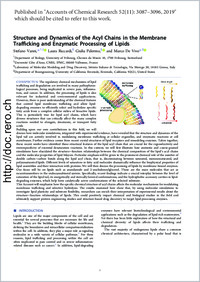Structure and dynamics of the acyl chains in the membrane trafficking and enzymatic processing of lipids
- Vanni, Stefano Department of Biology, University of Fribourg, Chemin du Musée 10, 1700 Fribourg, Switzerland - Université Côte d’Azur, CNRS, IPMC, 06560 Valbonne, France
- Riccardi, Laura Laboratory of Molecular Modeling and Drug Discovery, Istituto Italiano di Tecnologia, Via Morego 30, 16163 Genoa, Italy
- Palermo, Giulia Department of Bioengineering, University of California Riverside, Riverside, California 92521, United States
- De Vivo, Marco Laboratory of Molecular Modeling and Drug Discovery, Istituto Italiano di Tecnologia, Via Morego 30, 16163 Genoa, Italy
-
19.11.2019
Published in:
- Accounts of Chemical Research. - 2019, vol. 52, no. 11, p. 3087–3096
English
The regulatory chemical mechanisms of lipid trafficking and degradation are involved in many pathophysiological processes, being implicated in severe pain, inflammation, and cancer. In addition, the processing of lipids is also relevant for industrial and environmental applications. However, there is poor understanding of the chemical features that control lipid membrane trafficking and allow lipid-degrading enzymes to efficiently select and hydrolyze specific fatty acids from a complex cellular milieu of bioactive lipids. This is particularly true for lipid acyl chains, which have diverse structures that can critically affect the many complex reactions needed to elongate, desaturate, or transport fatty acids. Building upon our own contributions in this field, we will discuss how molecular simulations, integrated with experimental evidence, have revealed that the structure and dynamics of the lipid tail are actively involved in modulating membrane trafficking at cellular organelles, and enzymatic reactions at cell membranes. Further evidence comes from recent crystal structures of lipid receptors and remodeling enzymes. Taken together, these recent works have identified those structural features of the lipid acyl chain that are crucial for the regioselectivity and stereospecificity of essential desaturation reactions. In this context, we will first illustrate how atomistic and coarse- grained simulations have elucidated the structure–function relationships between the chemical composition of the lipid’s acyl chains and the molecular properties of lipid bilayers. Particular emphasis will be given to the prominent chemical role of the number of double carbon–carbon bonds along the lipid acyl chain, that is, discriminating between saturated, monounsaturated, and polyunsaturated lipids. Different levels of saturation in fatty acid molecules dramatically influence the biophysical properties of lipid assemblies and their interaction with proteins. We will then discuss the processing of lipids by membrane-bound enzymes. Our focus will be on lipids such as anandamide and 2-arachidonoylglycerol. These are the main molecules that act as neurotransmitters in the endocannabinoid system. Specifically, recent findings indicate a crucial interplay between the level of saturation of the lipid tail, its energetically and sterically favored conformations, and the hydrophobic accessory cavities in lipid-degrading enzymes, which help form catalytically active conformations of the selected substrate. This Account will emphasize how the specific chemical structure of acyl chains affects the molecular mechanisms for modulating membrane trafficking and selective hydrolysis. The results examined here show that, by using molecular simulations to investigate lipid plasticity and substrate flexibility, researchers can enrich their interpretation of experimental results about the structure–function relationships of lipids. This could positively impact chemical and biological studies in the field and ultimately support protein engineering studies and structure-based drug discovery to target lipid-processing enzymes.
- Faculty
- Faculté des sciences et de médecine
- Department
- Département de Biologie
- Language
-
- English
- Classification
- Biological sciences
- License
-
License undefined
- Identifiers
-
- RERO DOC 327687
- DOI 10.1021/acs.accounts.9b00134
- Persistent URL
- https://folia.unifr.ch/unifr/documents/308322
Statistics
Document views: 108
File downloads:
- pdf: 290
